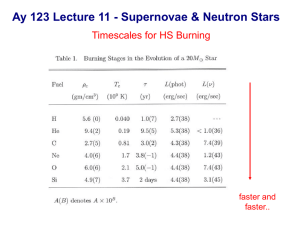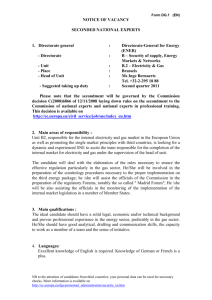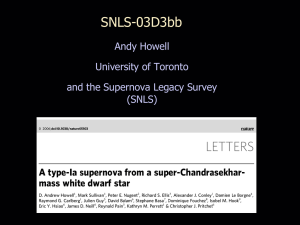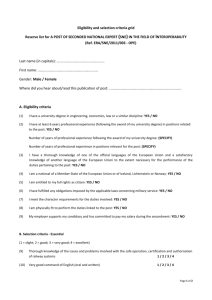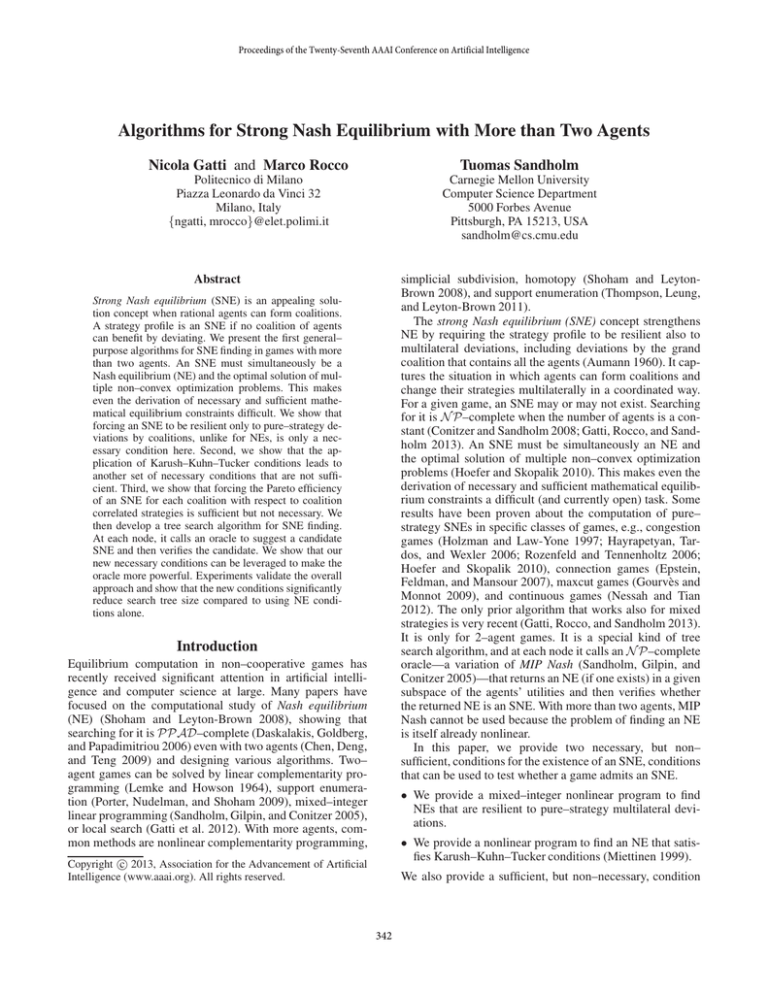
Proceedings of the Twenty-Seventh AAAI Conference on Artificial Intelligence
Algorithms for Strong Nash Equilibrium with More than Two Agents
Nicola Gatti and Marco Rocco
Tuomas Sandholm
Politecnico di Milano
Piazza Leonardo da Vinci 32
Milano, Italy
{ngatti, mrocco}@elet.polimi.it
Carnegie Mellon University
Computer Science Department
5000 Forbes Avenue
Pittsburgh, PA 15213, USA
sandholm@cs.cmu.edu
Abstract
simplicial subdivision, homotopy (Shoham and LeytonBrown 2008), and support enumeration (Thompson, Leung,
and Leyton-Brown 2011).
The strong Nash equilibrium (SNE) concept strengthens
NE by requiring the strategy profile to be resilient also to
multilateral deviations, including deviations by the grand
coalition that contains all the agents (Aumann 1960). It captures the situation in which agents can form coalitions and
change their strategies multilaterally in a coordinated way.
For a given game, an SNE may or may not exist. Searching
for it is N P–complete when the number of agents is a constant (Conitzer and Sandholm 2008; Gatti, Rocco, and Sandholm 2013). An SNE must be simultaneously an NE and
the optimal solution of multiple non–convex optimization
problems (Hoefer and Skopalik 2010). This makes even the
derivation of necessary and sufficient mathematical equilibrium constraints a difficult (and currently open) task. Some
results have been proven about the computation of pure–
strategy SNEs in specific classes of games, e.g., congestion
games (Holzman and Law-Yone 1997; Hayrapetyan, Tardos, and Wexler 2006; Rozenfeld and Tennenholtz 2006;
Hoefer and Skopalik 2010), connection games (Epstein,
Feldman, and Mansour 2007), maxcut games (Gourvès and
Monnot 2009), and continuous games (Nessah and Tian
2012). The only prior algorithm that works also for mixed
strategies is very recent (Gatti, Rocco, and Sandholm 2013).
It is only for 2–agent games. It is a special kind of tree
search algorithm, and at each node it calls an N P–complete
oracle—a variation of MIP Nash (Sandholm, Gilpin, and
Conitzer 2005)—that returns an NE (if one exists) in a given
subspace of the agents’ utilities and then verifies whether
the returned NE is an SNE. With more than two agents, MIP
Nash cannot be used because the problem of finding an NE
is itself already nonlinear.
In this paper, we provide two necessary, but non–
sufficient, conditions for the existence of an SNE, conditions
that can be used to test whether a game admits an SNE.
Strong Nash equilibrium (SNE) is an appealing solution concept when rational agents can form coalitions.
A strategy profile is an SNE if no coalition of agents
can benefit by deviating. We present the first general–
purpose algorithms for SNE finding in games with more
than two agents. An SNE must simultaneously be a
Nash equilibrium (NE) and the optimal solution of multiple non–convex optimization problems. This makes
even the derivation of necessary and sufficient mathematical equilibrium constraints difficult. We show that
forcing an SNE to be resilient only to pure–strategy deviations by coalitions, unlike for NEs, is only a necessary condition here. Second, we show that the application of Karush–Kuhn–Tucker conditions leads to
another set of necessary conditions that are not sufficient. Third, we show that forcing the Pareto efficiency
of an SNE for each coalition with respect to coalition
correlated strategies is sufficient but not necessary. We
then develop a tree search algorithm for SNE finding.
At each node, it calls an oracle to suggest a candidate
SNE and then verifies the candidate. We show that our
new necessary conditions can be leveraged to make the
oracle more powerful. Experiments validate the overall
approach and show that the new conditions significantly
reduce search tree size compared to using NE conditions alone.
Introduction
Equilibrium computation in non–cooperative games has
recently received significant attention in artificial intelligence and computer science at large. Many papers have
focused on the computational study of Nash equilibrium
(NE) (Shoham and Leyton-Brown 2008), showing that
searching for it is PPAD–complete (Daskalakis, Goldberg,
and Papadimitriou 2006) even with two agents (Chen, Deng,
and Teng 2009) and designing various algorithms. Two–
agent games can be solved by linear complementarity programming (Lemke and Howson 1964), support enumeration (Porter, Nudelman, and Shoham 2009), mixed–integer
linear programming (Sandholm, Gilpin, and Conitzer 2005),
or local search (Gatti et al. 2012). With more agents, common methods are nonlinear complementarity programming,
• We provide a mixed–integer nonlinear program to find
NEs that are resilient to pure–strategy multilateral deviations.
• We provide a nonlinear program to find an NE that satisfies Karush–Kuhn–Tucker conditions (Miettinen 1999).
c 2013, Association for the Advancement of Artificial
Copyright Intelligence (www.aaai.org). All rights reserved.
We also provide a sufficient, but non–necessary, condition
342
the expected utility given by every action ai available to
agent i. Constraints (2) force vi to be equal to the expected
utility given by every action ai that is played with positive
probability by agent i. Constraints (3) force each probability
xi (ai ) to be nonnegative. Constraints (4) force each agent’s
probabilities to sum to one.
An SNE (Aumann 1960) strengthens the NE concept requiring the strategy profile to be resilient also to multilateral
deviations by any coalition of agents. That is, in an SNE
no coalition of agents can deviate in a way that strictly increases the expected utility of each member of the coalition,
again keeping the strategies of the agents outside the coalition fixed. An SNE combines two concepts: an SNE is an
NE and it is weakly Pareto efficient over the space of all the
strategy profiles (including the mixed ones) for each possible coalition (fixing the strategies of the agents outside the
coalition). Unlike an NE, an SNE may not exist.
for the existence of an SNE that can be used to search for an
SNE.
• We provide a nonlinear program in which a strategy profile is forced to be Pareto efficient with respect to coalition
correlated strategies.
Then we characterize the relationships between the solutions of these three formulations, NEs, and SNEs.
Finally, we exploit these results to extend the prior SNE–
finding tree search algorithm (Gatti, Rocco, and Sandholm
2013) to multiple agents. We do this by introducing a generalization to the tree search framework and by leveraging our
necessary conditions in the oracle that is used at each search
node. We conduct experiments that validate the overall tree
search approach and show the benefits of our new nonlinear
necessary conditions in the oracle.
Game–theoretic preliminaries
Strong Nash equilibrium conditions
A strategic–form game (Shoham and Leyton-Brown 2008)
is a tuple (N, A, U ) where:
• N = {1, . . . , n} is the set of agents (we denote by i a
generic agent),
• A = A1 × . . . × An is the set of agents’ joint actions,
and Ai is the set of agent i’s actions (we denote a generic
action by a, and by mi the number of actions in Ai ),
• U = {U1 . . . , Un } is the set of agents’ utility arrays
where Ui (a1 , . . . , an ) is the utility of agent i when the
agents play actions a1 , . . . , an .
We denote by xi (ai ) the probability with which agent i plays
action ai ∈ Ai and by xi the vector of probabilities xi (ai )
of agent i. We denote by ∆i the space of well–defined probability vectors over Ai .
An NE is defined as a strategy profile x =
Q(x1 , . . . , xn )
such that, for each i ∈ N , xTi Ui j6=i x−j ≥
Q
′
x′T
i Ui
j6=i x−j for every xi ∈ ∆i . Every finite game admits at least one NE in mixed strategies, but an NE in pure
strategies may or may not exist. The problem of finding an
NE can be expressed as:
vi −
X
Ui (ai , a−i ) ·
Y
xj (aj ) ≥ 0
j∈N :
a−i ∈A−i
We focus on the problem of deriving equilibrium constraints
in a mathematical programming fashion for SNE. Denote
by C = {N ′ : N ′ ⊆ N, |N ′ | ≥ 2} the set of non–singleton
coalitions and by C ∈ C a generic coalition. Denote by aC
a profile of actions, one for each agent i that is a member of
C, where aC (i) is the action of agent i in aC , while a−C is
defined similarly for the agents that are not members of C.
A strategy profile x is an SNE if and only if:
• it is an NE, that is, it satisfies constraints (1)–(4), and
• it is Pareto efficient for each C ∈ C. That is, for each C, it
is an optimal solution to the multi–objective mathematical
program in which the objectives are the expected utilities
of the agents that are members of C:
max
xC
X
Ui (aC , a−C )·
(aC ,a−C )∈A
xj (aj ) : i ∈ C
(5)
∀aC ∈ AC
(6)
xi (ai ) ≥ 0
∀i ∈ C, ai ∈ Ai
(7)
xi (ai ) = 1
∀i ∈ C
(8)
·xC (aC ) ·
Y
j6∈C
∀i ∈ N,
(1)
ai ∈ Ai
xC (aC ) =
j6=i
Y
xi (aC (i))
i∈C
xi (ai ) ·
vi −
X
Ui (ai , a−i )·
a−i ∈A−i
·
Y
!
xj (aj )
j∈N :
=0
X
∀i ∈ N,
(2)
ai ∈ Ai
ai ∈Ai
Here the objective function (5) is the vector of the expected utility functions of the agents i of the coalition C.
Constraints (6) force the strategy xC of the coalition over
the profile aC to be equal to the product of the strategy
xi (aC (i)) of each single agent i of C. Constraints (7)
and (8) force xi to be a well–defined strategy.
The above formulations (i.e., NE constraints (1)–(4) and
multi–objective programs (5)–(8), one for each C) constitute separate programs that must be satisfied together. Their
j6=i
X
xi (ai ) ≥ 0
∀i ∈ N,
(3)
ai ∈ Ai
xi (ai ) = 1
∀i ∈ N (4)
ai ∈Ai
Here vi is the expected utility of agent i. Constraints (1)
force the expected utility vi of agent i to be no smaller than
343
integration is not straightforward. Consider, e.g., 2–agent
games. Only one coalition is possible, i.e., C = {1, 2}. If
we solve program (5)–(8) for C = {1, 2} with, as additional
constraints, NE constraints (1)–(4), we are searching for NE
that is Pareto efficient among all the NEs. Instead, an SNE is
an NE that is Pareto efficient among all the strategy profiles.
Thus, in order to find equilibrium constraints for SNE, we
need to translate, for each C, program (5)–(8) into a feasibility problem that is satisfied by, and only by, all the optimal solutions of (5)–(8). The derivation of such necessary
and sufficient equilibrium constraints is an open problem. It
is elusive because program (5)–(8) is non–convex and therefore strong duality and complementary slackness conditions
do not hold—unlike in the case of NE. In the next three
subsections we derive necessary or sufficient conditions for
SNE using three different ideas, respectively.
is, if playing aC is the best for all the members of the coalition, then this multilateral deviation is active and the utility
of each member of the coalition must be at least the utility
given by playing aC . Finding an NE that is resilient to pure
multilateral deviations can then be formulated as:
constraints (1), (2), (3), (4)
constraints (9), (10), (11) for all C ∈ C
If there are only two agents, this set of constraints constitutes a mixed integer linear program, given that the NE
constraints can be expressed in mixed integer linear fashion (Sandholm, Gilpin, and Conitzer 2005).
We can state the following theorem, whose proof easily
follows from the derivation above.
NEs resilient to pure multilateral deviations
However, unlike in the case of NE, they are not sufficient:
Theorem 1 The above constraints are necessary conditions
for a strategy profile to be an SNE.
Our approach in this subsection is to require Pareto optimality of a solution w.r.t. only pure joint strategies (i.e., no coalition can deviate from a strategy profile to a pure–strategy
profile that is strictly Pareto dominant for that coalition).
A motivation for this approach comes from what is known
for NE. Although the NE concept requires a strategy to be
the best w.r.t all mixed strategies, it is sufficient to require
that a strategy is best w.r.t. all pure–strategy deviations.
Obviously, resilience to pure multilateral deviations is a
necessary condition for an SNE. However, constraining a
strategy to be Pareto optimal w.r.t. pure coalition strategies
is not straightforward. A unilateral deviation is always possible, i.e., for each strategy, if there is an action that is better
than the strategy, the agent will deviate. Instead, a multilateral deviation is possible if and only if all the members
of the coalition can gain more by deviating. The need for
activating and deactivating constraints related to a multilateral deviation pushes us to resort to mixed integer programming. Given a coalition C, we can formulate the constraints
to force an NE to be resilient to pure multilateral deviations
of C as a mixed integer nonlinear program:
ri,C (aC ) ∈ {0, 1}
vi −
X
Y
Ui (aC , a−C ) ·
a−C ∈A−C
vi −
Proof. Consider the game in Fig. 1. There are three NEs: one
pure, (a3 , a6 ), and two mixed, ( 12 a1 + 21 a2 , 12 a4 + 21 a5 ) and
( 17 a1 + 71 a2 + 75 a3 , 17 a4 + 71 a5 + 75 a6 ). Focus on (a3 , a6 ): there
is no outcome achievable by pure–strategy multilateral deviations that provides both agents a utility strictly greater than
1. For instance, (a1 , a4 ) is better for agent 1 than (a3 , a6 ), but
it is not for agent 2. With (a2 , a4 ) we have the reverse. However, (a3 , a6 ) is not weakly Pareto efficient, as shown by the
Pareto frontier in the figure. Indeed, ( 12 a1 + 21 a2 , 21 a4 + 12 a5 )
strictly Pareto dominates (a3 , a6 ). The former, being on the
Pareto frontier, is an SNE.
X
j∈C
(9)
j∈−C
xj (aj ) ≥ −M · ri,C (aC )
b
SNE
2
b
1
NE
b
0
1
2
3
E[U1 ]
4
5
Figure 1: 2–agent game (left) and its Pareto frontier (right).
∀i ∈ C,
aC ∈ A C
(10)
The above conditions are stronger than the NE conditions
(the proof is omitted because it is trivial):
Ui (aC , a−C )·
Y
3
0
Proposition 3 There are NEs that do not satisfy constraints (9)–(11).
a−C ∈A−C
·
4
NE
xj (aj ) ≥
rj,C (aC ))
a1
a2
a3
agent 2
a4
a5
a6
5, 0 0, 5 0, 0
0, 5 5, 0 0, 0
0, 0 0, 0 1, 1
E[U2 ]
agent 1
5
j∈−C
−M · (|C| −
X
∀i ∈ C,
aC ∈ A C
Theorem 2 Resilience to pure multilateral deviations is not
sufficient for SNE.
∀i ∈ C,
aC ∈ A C
(11)
NEs satisfying KKT conditions
where M is the largest payoff of all the agents. Constraints (9) force ri,C (aC ) to take on binary values. If the
left hand side of (11) is negative, then ri,C (aC ) = 1. Constraints (10) force the left hand side to be positive if the variables ri,C (aC ) of all the members of the coalition are 1. That
In this subsection, we present our second formulation approach, which is based on Karush–Kuhn–Tucker (KKT)
conditions. Multi–objective programming provides KKT
techniques to derive optimality (i.e., Pareto efficiency) conditions. These conditions are:
344
Proof. Consider the game in Fig. 2. The game admits a
mixed strategy NE ( 12 a1 + 21 a2 , 12 a5 + 21 a6 ) that gives each
of the two agents utility 1. This NE is Pareto dominated by,
e.g., ( 12 a3 + 12 a4 , 12 a7 + 12 a8 ) that gives each agent utility
9
4 . The previous NE satisfies KKT conditions for all feasible
λ1 , λ2 with µ1 (a3 ) = µ1 (a4 ) = µ2 (a7 ) = µ2 (a8 ) = 6 and
ν1 = ν2 = 1.
µj · ∇gj (z)+
j
+
X
νk · ∇hk (z) = 0
(12)
k
µj · gj (z) = 0
λi , µj ≥ 0
X
λi = 1
∀j
∀i, j
(13)
(14)
(15)
agent 1
i
where fi (z) are the objective functions to minimize, gj (z)
are inequality constraints of the form gj (z) ≤ 0, hk are
equality constraints of the form hk (z) = 0. The λi , µj , νk
are called KKT multipliers: λi is the weight of objective
function fi , µj is the weight of constraint gj , and νk is the
weight of constraint hk .
KKT conditions (12)–(15) are necessary conditions for local Pareto efficiency (Miettinen 1999). We can map these
conditions to the case of Pareto efficiency for a single coalition C as follows:
·
Y
b
1
NE
1
2
3
4
5
Figure 2: 2–agent game (left) and its Pareto frontier (right).
Proposition 6 There are NEs that do not satisfy constraints (16)–(20).
Proof. Consider the game in Fig. 3. We show that KKT conditions are not satisfied at the NE (a2 , a4 ). KKT conditions
at x1 (a2 ) = x2 (a4 ) = 1 are: µ1 (a2 ) = 0, µ2 (a4 ) = 0,
5λ2 + µ1 (a1 ) = ν1 , λ1 + λ2 = ν1 , 5λ1 + µ2 (a3 ) = ν2 ,
λ1 + λ2 = ν2 . By straightforward mathematics, we obtain
3λ1 + 3λ2 = −µ1 (a1 ) − µ2 (a3 )
P
Given that λi , µi (ai ) ≥ 0 and i∈N λ = 1, the above
equality is unsatisfiable and therefore KKT conditions are
not satisfied.
Ui (a)·xj (aj )·
a∈A: j∈C:
aw =aw j6=w
5
xj (aj ) − µC (aw ) + νw,C = 0
j6∈C
−µC (ai ) · xi (ai ) = 0
λi,C ≥ 0
µC (ai ) ≥ 0
X
∀w ∈ C,
(16)
aw ∈ Aw
agent 1
i∈C
X Y
2
E[U1 ]
Given a coalition C, we obtain the following conditions:
λi,C ·
3
0
• gj : is a constraint of the form −xw (aw ) ≤ 0;
P
• hk : is a constraint of the form ai ∈Ai xi (ai ) − 1 = 0.
X
4
0
• fi : is agent i’s expected utility multiplied by ‘−1’ (given
that in KKT fi is to minimize);
−
a1
a2
a3
a4
5
agent 2
a5
a6
a7
a8
2, 0
0, 2
−5, −5 −5, −5
0, 2
2, 0
−5, −5 −5, −5
−5, −5 −5, −5
5, 0
0, 0
−5, −5 −5, −5
0, 0
0, 5
E[U2 ]
λi · ∇fi (z) +
i
X
∀i ∈ C,
(17)
ai ∈ Ai
∀i ∈ C (18)
∀i ∈ C,
(19)
ai ∈ Ai
λi,C = 1
a1
a2
agent 2
a3
a4
3, 3 0, 5
5, 0 1, 1
4
3
E[U2 ]
X
2
b
1
NE
0
0
1
2
3
E[U1 ]
4
5
Figure 3: Example game (prisoner’s dilemma) without any
SNE (left) and Pareto frontier (right).
(20)
i∈C
NEs on the correlated Pareto frontier
Now, we can leverage the above results, producing a nonlinear mathematical program for SNE as follows:
constraints (1), (2), (3), (4)
constraints (16)–(20) ∀C ∈ C
We can state the following theorem, whose proof easily
follows from the derivation above.
In this subsection, we present our third formulation approach. In order to provide sufficient conditions, we relax
the constraints of program (5)–(8), allowing the agents belonging to coalition C to play correlated strategies. Correlated strategies include all the mixed strategies. Thus, if a
strategy profile of the members of coalition C is the best
w.r.t. all their correlated strategies, then it is the best also
w.r.t. all the mixed strategies. However, requiring optimality
w.r.t. correlated strategies, we may discard solutions that are
optimal w.r.t. mixed strategies.
At first, we reformulate program (5)–(8) when the members of coalition C can play correlated strategies:
Theorem 4 The above constraints are necessary conditions
for a strategy profile to be an SNE.
However, such conditions are not sufficient.
Theorem 5 The above constraints are not sufficient for a
strategy profile to be an SNE, nor for NEs to be locally
Pareto efficient.
345
Theorem 7 The above constraints are sufficient conditions
for a strategy profile to be an SNE.
objective (5)
∀a ∈ AC
xC (a) = 1
(21)
However, the above conditions are not necessary:
(22)
Theorem 8 The above constraints are not necessary conditions for a strategy profile to be an SNE.
a∈AC
Proof. Consider Fig. 4, where ρ is arbitrarily small. The
game has one SNE, i.e., (a3 , a6 ), but this SNE does not
satisfy the above constraints. Indeed, the agents’ utilities at
(a3 , a6 ), i.e., (2, 2), are not on the correlated–strategy Pareto
frontier, i.e., the dashed line connecting (5,0) to (0,5). Thus,
the above nonlinear mathematical program is infeasible. Given that the above optimization problem is convex (i.e.,
linear in xC ), we have that, if a solution xC is optimal for
program (5), (21), (22), then there is a vector of multipliers
λi ≥ 0 in which at least one multiplier is strictly positive
such that xC is an optimal solution of the following problem:
constraints (21), (22)
X
X
max
λi,C ·
Ui (aC , a−C )·
i∈C
5
(aC ,a−C )∈A
·xC (aC ) ·
Y
xj (aj )
(23)
agent 1
xC
j6∈C
We derive the dual problem of problem (21), (22), (23). It is:
a1
a2
a3
agent 2
a4
a5
a6
5, 0 0, 0 0, ρ
0, 0 0, 5 0, ρ
ρ, 0 ρ, 0 2, 2
4
3
E[U2 ]
xC (a) ≥ 0
X
b
2
SNE
1
0
min vC
vC
X
λi,C ·
i∈C
X
2
3
E[U1 ]
4
5
Figure 4: 2–agent game (left) and its Pareto frontier (right).
Ui (aC , a−C )·
a−C ∈A−C
·
Y
xj (aj ) ∀ac ∈ Ac (25)
Relationships between the solutions
j6∈C
We now study the relationships between the solutions found
by the formulations provided in the previous subsections.
Call NEPMDs the NEs that are resilient to pure multilateral
deviations, NEKKTs the NEs that satisfy the KKT conditions, and corrSNEs the SNEs that are Pareto efficient w.r.t.
the correlated strategies.
where vC is the dual variable of constraint (22). Given that
the primal problem is convex, strong duality holds and we
can apply the complementary slackness theorem, obtaining
the following feasibility problem:
constraints (21), (22), (25)
X
X
xC (ac ) · vC −
λi,C ·
Ui (aC , a−C )·
Proposition 9 NEKKTs 6⊆ NEPMDs and NEPMDs 6⊆
NEKKTs.
Proof. We prove this by a pair of counterexamples. The NE
( 13 a1 + 32 a2 , 34 a3 + 14 a4 ) of the game in Fig. 5 is an NEPMD,
while it is not an NEKKT, and therefore NEKKTs do not
constitute a subset of NEPMDs; the NE (a3 , a6 ) of the game
in Fig. 6 is an NEKKT, while it is not an NEPMD, and therefore NEPMDs does not constitute a subset of NEKKTs. a−C ∈A−C
i∈C
·
Y
j6∈C
xj (aj ) = 0 ∀ac ∈ Ac (26)
The above constraints are sufficient conditions for a strategy profile xC to be Pareto efficient once the strategies of
agents outside C are fixed. Now, we can leverage the above
results to produce a nonlinear program for SNE:
constraints (1), (2), (3), (4)
constraints (6), (25), (26) ∀C ∈ C
X
1
∀i ∈ C, C ∈ C
(27)
λi,C = 1
∀C ∈ C
(28)
agent 1
λi,C ≥ 0
3
a1
a2
agent 2
a3
a4
1, 0 0, 2
0, 1 3, 0
2
E[U2 ]
vC ≥
0
(24)
1
b
NE
0
0
i∈C
1
2
E[U1 ]
3
Figure 5: 2–agent game (left) and its Pareto frontier (right).
where constraints (1)–(4) assure that x is an NE; constraints
(6), (25), (26) ∀C ∈ C and constraints (27), (28) assure that,
for every C, there are some well–defined multipliers λi,C
such that xC is optimal (among all the correlated strategies)
and therefore xC is Pareto efficient. We can state the following theorem, whose proof easily follows from above.
Proposition 10 SNEs ⊂ (NEKKTs ∩ NEPMDs).
Proof. The NE ( 21 a1 + 12 a2 , 12 a5 + 12 a6 ) of Fig. 2 is an
NEPMD and an NEKKT, but it is not an SNE.
So, the relationships between the solutions are:
346
if there is a Pareto dominant solution (U i , U j ) for the coalition C = {i, j}, we generate
a1
a2
a3
4
E[U2 ]
agent 1
5
agent 2
a4
a5
a6
5, 2 0, 0 0, 0
0, 0 2, 5 0, 0
0, 0 0, 0 1, 1
• s∗1 = [Uimin , Uimax ] × [U j , Ujmax ] ∪ {xk },
3
2
b
1
• s∗2 = [U i , Uimax ] × [Ujmin , U j ] ∪ {xk },
NE
where k ∈ N \ C. If s∗ turns out to be Pareto dominated, we generate the same states generated with 2–agent
games, keeping fix the strategy of i ∈ −C. The algorithm is
called recursively on each of the newly–generated states. Finally, we need to check dominance considering all the three
agents.
Second, for the oracle, we need a different method than
in the 2–agent case because MIP Nash (Sandholm, Gilpin,
and Conitzer 2005) is based on integer linear programming,
and with more than two agents the NE–finding program is
nonlinear. For the oracle, we adopt (from earlier in this paper) formulations for NEs, NEPMDs (in place of integrity
constraints r ∈ {0, 1}, we use constraints r · (1 − r) = 0
and r ≥ 0), NEKKTs, NEPMDs∩NEKKTs. As we proved,
these are necessary but not sufficient conditions for SNE.
Once such a candidate solution is found, we check whether
it really is an SNE using the same algorithm as in the prior 2–
agent algorithm, and that verification algorithm is still polynomial. If the oracle finds just an NE at that tree search
node although an SNE exists at that node, that is no problem because the SNE will be encountered later in the tree
search. On the other hand, if the oracle fails to find any NE
at that tree search node—e.g., because the nonlinear mathematical program of the oracle is solved with an incomplete
algorithm—although an SNE exists at that tree search node,
the overall algorithm can become incomplete.
0
0
1
2
3
E[U1 ]
4
5
Figure 6: 2–agent game (left) and its Pareto frontier (right).
corrSNEs ⊂ SNEs ⊂ (NEKKTs ∩ NEPMDs)
⊂ NEPMDs ⊂
NEs
⊂ NEKKTs ⊂
Algorithm for finding an SNE in games with
more than two agents
Recently a tree search algorithm was presented for finding an SNE in 2–agent games (Gatti, Rocco, and Sandholm
2013). We extend it to multiple agents. For simplicity, we
present the new tree search algorithm for three agents, but
the generalization to more than three is immediate.
The 2–agent algorithm works as follows. A state s is
a subspace of the agents’ utility space defined as s =
[U1min , U1max ] × [U2min , U2max ]. The algorithm is first called
with s being the entire space. At each call of the algorithm, the algorithm calls an NE–finding oracle to find an
NE (or to state that none exists) in the subspace s. If there
is an NE, a verification algorithm is then called to check
whether the NE is an SNE by checking whether there is
a solution with utility (U 1 , U 2 ) that Pareto dominates the
NE. The oracle that was adopted is MIP Nash (Sandholm,
Gilpin, and Conitzer 2005). The verification algorithm is described in (Gatti, Rocco, and Sandholm 2013) and its complexity is polynomial. If there is a Pareto dominant solution (U 1 , U 2 )—so the NE is not an SNE—the algorithm
generates two states s1 = [U1min , U1max ] × [U 2 , U2max ] and
s2 = [U 1 , U1max ] × [U2min , U 2 ], and calls itself with these
states recursively.
We extend the algorithm to the 3–agent case as follows.
First, we need to generalize the tree search framework.
States are defined as s = [U1min , U1max ] × [U2min , U2max ] ×
[U3min , U3max ]. In addition, there are now special states s∗
defined as [Uimin , Uimax ] × [Ujmin, Ujmax ] ∪ {xk }, where the
strategy of agent k is fixed. For states s, an SNE–candidate–
finding oracle for 3–agent games is called. For s∗ , an SNE–
candidate–finding oracle for 2–agent games is called. At
each iteration the algorithm randomly chooses a state s
or s∗ . Given an NE (x1 , x2 , x3 ) in s = [U1min , U1max ] ×
[U2min , U2max ] × [U3min , U3max ], if there is a Pareto dominant
solution (U 1 , U 2 , U 3 ) for the grand coalition, we generate
Experiments
We implemented the tree search algorithm in the C programming language. For the oracle formulations therein,
we used AMPL (Fourer, Gay, and Kernighan 1990) as the
modeling language and SNOPT (Stanford Business Software Inc. 2012) to solve them. The experiments were conducted on an Intel 2.20GHz processor with Linux kernel
2.6.32. We ran on 20 instances of class RandomGames1
of GAMUT (Nudelman et al. 2004) for each setting of
the parameters: 10, 20, and 25 actions for 2–agent games,
2, . . . , 10 actions for 3–agent games.
SNOPT uses sparse sequential quadratic programming
and thus is not complete.2 To make the oracle more complete, we used uniform random restarts over the strategy
space (Onn and Weissman 2011) and called SNOPT on each
restart. In Tab. 1 we report the percentage of runs where
SNOPT finds an NE in 2–agent games: it shows that 50 random restarts are needed to have satisfactory reliability. One
run of SNOPT on the formulations NEMDP, NEKKT, and
corrSNE required compute time similar to that reported in
1
We report data for RandomGames because it is the most representative class
among the GAMUT classes.
• s1 = [U 1 , U1max ] × [U2min , U2max ] × [U3min , U3max ],
• s2 =
[U1min , U 1 ]
• s3 =
[U1min , U 1 ]
×
[U 2 , U2max ]
×
×
[U2min , U 2 ]
× [U 3 , U3max ];
2
We also evaluated global optimization solver Couenne (http://www.coinor.org/Couenne/). Turns out it was applicable only to instances with less than 5
actions in 2–agent games, since it required a long time (over an hour) on larger instances.
[U3min , U3max ],
347
the table. The compute time per restart is relatively small
(few seconds), but, due to the large number of restarts, it
is much larger (by about two orders of magnitude) than the
compute time needed by MIP Nash, which takes less than
one second and does not require restarts (Sandholm, Gilpin,
and Conitzer 2005).
actions
per
agent
average time
per restart
10
20
restarts
30
40
50
2.1 s
3.2 s
6.3 s
50%
40%
30%
80%
65%
50%
90%
73%
63%
95%
85%
77%
98%
96%
94%
10
20
25
left open. Then, we developed a tree search algorithm for
SNE finding, and leveraged our necessary conditions to obtain better oracles for use at the search tree nodes.
Experiments showed the viability of the approach. Using the new necessary conditions in the oracle significantly
reduces search tree size compared to using NE conditions
alone. Also, the sufficient conditions often yield an SNE,
but as the game size increases, this becomes less likely.
This work underlined that nonlinear mathematical programming tools—albeit necessary because the SNE problem
with more than two agents is nonlinear—have drawbacks:
they require random restarts and may cause incompleteness.
In future work, we plan to evaluate in depth the performance
of both non–linear programming solvers and mathematical
programming with equilibrium constraints (Luo, Pang, and
Ralph 1996) solvers. We also plan to study approximation
algorithms for SNE. Finally, we plan to study SNE finding
in compactly representable games that do not require nonlinear programming, such as polymatrix games.
Table 1: SNOPT performance in finding an NE.
With 50 random restarts of SNOPT in each oracle call, we
evaluated our approaches of finding an SNE (or stating that
none exists) on 3–agent games, Tab. 2. The average time per
restart is similar for all the formulations (NEMDP, NEKKT,
and corrSNE) and, due to limited space, we report only the
average across the formulations. The average number of tree
search nodes (i.e., calls to the oracle) per formulation shows
that our new necessary formulations for SNE significantly
reduce the number of nodes compared to just using an NE–
finding oracle. Finally, corrSNE returns the correct solution
with low percentage.
actions
per agent
av. time
per restart
5
6
7
8
9
10
6.3 s
8.6 s
10.1 s
15.6 s
19.4 s
25.8 s
tree search nodes (i.e., calls to the oracle)
NE NEPMD NEKKT NEPMD∩NEKKT
3.0
3.6
4.1
4.7
6.4
5.6
1.0
1.2
1.1
1.0
1.1
1.1
1.3
1.6
1.5
1.8
1.7
1.8
1.0
1.0
1.1
1.0
1.1
1.1
Acknowledgments
N. Gatti was supported by MIUR under grant 2009BZM837.
T. Sandholm was supported by NSF under grants IIS–
0964579 and CCF–1101668.
References
Aumann, R. 1960. Acceptable points in games of perfect
information. PAC J MATH 10:381–417.
Chen, X.; Deng, X.; and Teng, S.-H. 2009. Settling the complexity of computing two–player Nash equilibria. J ACM
56(3):14:1–14:57.
Conitzer, V., and Sandholm, T. 2008. New complexity results about Nash equilibria. GAME ECON BEHAV
63(2):621–641.
Daskalakis, C.; Goldberg, P.; and Papadimitriou, C. 2006.
The complexity of computing a Nash equilibrium. In STOC,
71–78.
Epstein, A.; Feldman, M.; and Mansour, Y. 2007. Strong
equilibrium in cost sharing connection games. In ACM EC,
84–92.
Fourer, R.; Gay, D.; and Kernighan, B. 1990. A modeling language for mathematical programming. Management
Science 36(5):519–554.
Gatti, N.; Patrini, G.; Rocco, M.; and Sandholm, T. 2012.
Combining local search techniques and path following for
bimatrix games. In UAI, 286–295.
Gatti, N.; Rocco, M.; and Sandholm, T. 2013. On the verification and computation of strong Nash equilibrium. In
AAMAS.
Gourvès, L., and Monnot, J. 2009. On strong equilibria in
the max cut game. In WINE, 608–615.
Hayrapetyan, A.; Tardos, E.; and Wexler, T. 2006. The effect
of collusion in congestion games. In STOC, 89–98.
Hoefer, M., and Skopalik, A. 2010. On the complexity of
Pareto–optimal Nash and strong equilibria. In SAGT, 312–
322.
success
corrSNE
45%
25%
20%
15%
10%
10%
Table 2: Performance to find an SNE (or state that none exists) in 3–agent games.
In 2–agent games, the reduction in the number of tree
search nodes is similar to the one in Tab. 2 (less than one
order of magnitude), but, in this case, it is not enough to
make our new nonlinear formulations faster than MIP Nash.
This is because, as said above, the new oracles requires a
much longer time due to random restarts.
Conclusions and future research
In this paper, we presented the first general–purpose algorithms for strong Nash equilibrium (SNE) finding in games
with more than two agents. We first derived a nonlinear program for finding a Nash equilibrium (NE) that is resilient to
pure–strategy coalitional deviations, and showed that it is a
necessary condition for SNE but not sufficient. Second, we
derived a nonlinear program to find NEs that satisfy Karush–
Kuhn–Tucker conditions and showed that it is necessary for
SNE but not sufficient. Third, we derived a nonlinear program to find NEs that are Pareto efficient for each coalition
with respect to coalition correlated strategies, and showed
that it is sufficient for SNE but not necessary. The problem
whether there is a necessary and sufficient set of equilibrium constraints in mathematical programming fashion is
348
Holzman, R., and Law-Yone, N. 1997. Strong equilibrium
in congestion games. GAME ECON BEHAV 21:85–101.
Lemke, C., and Howson, J. 1964. Equilibrium points of
bimatrix games. SIAM J APPL MATH 12(2):413–423.
Luo, Z.-Q.; Pang, J.-S.; and Ralph, D. 1996. Mathematical
Programs with Equilibrium Constraints. Cambridge University Press.
Miettinen, K. 1999. Multiobjective Optimization. Kluwer.
Nessah, R., and Tian, G. 2012. On the existence of strong
Nash equilibria. IESEG School of Management, Working
Paper.
Nudelman, E.; Wortman, J.; Leyton-Brown, K.; and
Shoham, Y. 2004. Run the GAMUT: A comprehensive approach to evaluating game–theoretic algorithms. In AAMAS,
880–887.
Onn, S., and Weissman, I. 2011. Generating uniform random vectors over a simplex with implications to the volume
of a certain polytope and to multivariate extremes. Annals
of Operations Research 189(1):331–342.
Porter, R.; Nudelman, E.; and Shoham, Y. 2009. Simple search methods for finding a Nash equilibrium. GAME
ECON BEHAV 63:642–662.
Rozenfeld, O., and Tennenholtz, M. 2006. Strong and correlated strong equilibria in monotone congestion games. In
WINE, 74–86.
Sandholm, T.; Gilpin, A.; and Conitzer, V. 2005. Mixed–
integer programming methods for finding Nash equilibria.
In AAAI, 495–501.
Shoham, Y., and Leyton-Brown, K. 2008. Multiagent Systems: Algorithmic, Game Theoretic and Logical Foundations. Cambridge University Press.
Stanford Business Software Inc. 2012. http://www.sbsi-soloptimize.com/.
Thompson, D. R. M.; Leung, S.; and Leyton-Brown, K.
2011. Computing Nash equilibria of action–graph games
via support enumeration. In WINE, 338–350.
349


